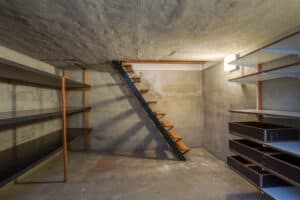
Years ago, it was quite common to have a water well or a cistern.
The well would sit under the house and work as a reservoir for holding water.
The water might have been used for household needs or landscaping.
Most of these water wells were not used for drinking water, at least in more modern times.
If you have purchased an older house and there is a water well in the basement, you will have a few choices as to what can be done.
Old Water Well in Basement (What to Do)

If you find an old water well in your basement, you are going to have three basic options.
The first option will be to fill it in, but you can also use it to store water or to collect rainwater.
Depending on what you decide to do with your old water well, you will have to make sure it is functioning properly, and there are no environmental issues with the well.
Each of these options will have some positives and negatives to it.
Some people find that the easiest thing to do is to fill the well in, but this still requires making sure that the process is done right.
1. Filling in the Well
When you decide that you have no need for the well and you want to fill it in, you will have some steps in front of you.
Some areas of the world require that you have the local environmental agency come over and take a look at the well first.
Since these wells are sometimes deep and they are going to affect the groundwater in the area, they need to be dealt with properly.
It can sometimes cost a few hundred dollars just to have the well checked out.
Unfortunately, this is a necessity to make sure that you get it done properly.
Once you have inspected the well and fully decided that you want to fill it, you will first need to seal it.
If you don’t seal it first, the well will continue to hold and collect water.
When you seal a well, you will first have to empty it and ensure that all the water is out.
Then you will seal the well so no more water can collect.
Once the well is sealed, it usually gets filled with a combination of sand, gravel, and concrete.
These materials will provide a stable base and allow for the well to eventually have flooring material placed on top of it.
If you have a well that has a tank, the tank may need to be taken apart entirely before you can complete this process.
Some people wonder what the issue is with just putting a cap on the well and being done with it.
Unfortunately, this is a bad option because it can lead to water and mildew issues.
Left untreated, these issues will then cause structural problems in the future.
Do yourself a favor, and don’t simply install flooring on top of your old well.
You will end up having to pull it up and deal with the issues later on.
2. Storing Water
As you can imagine, the old water wells are designed to store water.
You can continue to use your well for this same purpose.
Since the well is likely quite old, you may want to make some updates to it before using the water in the well.
Most people will install a steel casing in the well.
The steel seems to be a better material to prevent the accumulation of bacteria and mold.
Once you have the steel casing in place, then you will want to look into the pumping mechanism.
If your well or cistern is older, chances are the pump and plumbing mechanism may be in need of an update.
Luckily, you can then attach this to your current plumbing system.
Many people will use this water for consuming and showering, but you will have to have the water tested and potentially filtered as well.
Converting one of these old pumps into a modern plumbing fixture is a bit of a project, but some find that it helps them to save on water.
3. Collecting Rainwater
One of the most common ways to use the old water well in the basement is to collect rainwater.
If you can find a way to collect rainwater, you can then use it in your landscaping.
This is a great way to water your grass and your garden.
Not only do you save money on the water, but the rainwater is actually better for your plants.
To collect rainwater, you will have to attach gutter pipes and collection devices to get the water to filter into the well.
Once you have the water in the well, you can create a spout which you will then hook up to a hose for you to use in your yard.
Rainwater collection is becoming more and more popular.
People realize that the more you can capitalize on the natural resources, the more money you can save.
The biggest problem people have with collecting rainwater is where and how to use it.
If you have an old well, you will have plenty of storage space for collecting this water.
Are Old Wells Dangerous?

An old well in your basement can end up being dangerous.
The reason is that many of these wells are not sealed or filled in correctly.
If you have an old well on your property and you have had it checked and are using it, it is not dangerous.
However, if you happen to stumble upon one that is not properly treated or closed up, you will then need to handle it.
If you are unsure of the status of your current well, then you can have a professional come over and inspect it.
How Do I Know If My Property Has an Old Well?

Sometimes you may want to use an old well, but you have no idea whether or not you have one.
There are some signs that you can look for on your property to determine if you have a well.
Not all of these wells are going to be in the basement.
Many people will have a well in the yard which is likely used for farming purposes.
Here are a few of the signs that will alert you to whether or not you have a well on your property.
1. Pipes
Do you see any pipes sticking out of the ground on your property?
You may notice that these pipes don’t seem to be connected to other parts of your plumbing.
There may be no rhyme or reason to the location of these pipes either.
This is a good indication that there is something else going on in your yard.
2. Well House
Many old properties have a small building that is called a well house.
This is a small area where the well was housed and kept protected from the elements.
These are usually relatively easy to find and will stand out when you purchase the property.
3. Depression
Sometimes a well will look like a large depression in the ground.
If the well is older or was filled in on top of the original, that area in your yard may not be all that level.
If you notice this depression, it is a good idea to call in a professional to make sure that the depression is, in fact, a well and not something else going on in the yard.
We don’t recommend starting to dig this up on your own.
4. Concrete Pit
A concrete pit may be filled in, or it may have some boards over the top of it.
The concrete pit is an indication that there was once a well in that area.
Depending on the way the well was closed in, it may or may not still be usable.
5. Property Title
Check the title of the piece of property you are purchasing.
If you look at the title or the survey, you should be able to see if there was a well.
Of course, this well would have had to have been installed with the proper permits to be included on these documents.
Sometimes homeowners will do things with their property without releasing this information to the local town or government.
This, of course, leads to inaccurate information on the title.
6. Water Utility History
Another way to see if the home has a well is to check the water utility history.
The history should give you an indication if the water was being drawn from the well or if it was being pulled from the local water utilities.
If a family of five was living in the home and using a very small amount of water on a weekly basis, chances are there was a well that was functioning at one point.
Do Water Wells Need to Be Inspected Often?

You should have the water well inspected once per year.
If you are using the water in the well, you need to make sure it is safe to use.
When a well is inspected, there are a few things that the well service company will do to ensure that it is safe and ready to use.
1. Flow Test
When a well is inspected, a flow test must be done to see how the water is flowing.
The pump will also be looked at in addition to any pressure switches.
Pumps tend to have the most trouble when it comes to issues that can happen with your water wells.
Since pumps have a mix of water and electricity, there is more potential for error with these.
You will notice that the output of the pump can also lead to any issues that could be happening with your system.
2. Code Requirements
As you can imagine, there are certain code requirements that your code will be required to meet.
If your well is not up to code, not only is it unsafe, but you could be left with fines as well.
A certified well inspector and contractor will understand the current code and know how to get your well up to code.
You won’t have to worry about understanding these individual requirements if you hire someone who knows what they are doing.
Undoubtedly, there are sanitary requirements which will be part of the local code as well.
3. Water Testing
Of course, as part of your annual well testing, the water coming from the well will need to be properly tested.
The water needs to be free of bacteria and nitrates.
If you are using the water for consumption, it is even more critical to ensure the water is stable and safe.
However, even if you are only using this water for your yard and garden, it is essential to know the levels of certain elements in the water to make sure they are safe.
The water will need to be tested for things like iron, manganese, and sulfides.
If the water has issues with any of these minerals, it can cause stains and the water could actually smell as well.
If the well happens to be under your home, this odor problem can be a real issue.
You may notice that some of the fixtures have bacterial growth on them.
This is another issue that will require treatment before the water from the well is useable.
If your area does not have a water well contractor, you can try to contact the local health department to see if they have a resource.
4. Inspection Report
At the end of your well testing, you should receive an inspection report.
This report will fill you in on everything that was inspected and done with your current well.
These reports are essential to have for making sure you can prove to any local agencies that you have had your well inspected and brought up to date.
It is also important to have well inspection reports to give to future owners in the event of a sale.
If you plan on selling your home, you must disclose the fact that you have a well and explain what it is used for.
You can tell the potential buyers that the well is up to code and that all proper checks have been done every year.
Nobody wants to inherit a problem, and there are quite a few problems that can come up with an old water well, especially one located in a basement.
Keep yourself out of these situations by following a good general maintenance routine.
Conclusion
Having an old water well in the basement does not have to be a bad thing.
Although you may decide to cover the well, you could also find that you have a use for the well.
The great news is that you have some choices, and you will find something that works well for your needs.
We highly recommend calling in a certified water well contractor to look at your well’s current condition.
Knowing where you stand and what you have to do to get your well working again is essential.
You will want to make sure that you are always following local code and health guidelines.



Leave a Reply